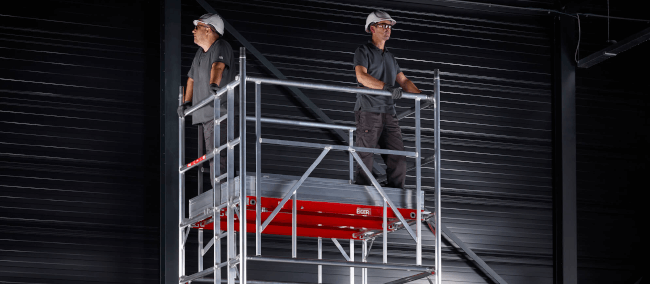- News & Articles
-
Products
Product Ranges
Product Categories
- Hire
- Buy
- About
- Resources
- After Sales Service
- Make an Enquiry

Working at height can be dangerous if either risk assessments aren’t created and actioned, or if basic safety guidelines are overlooked by users.
We’ve previously covered information on how to perform a risk assessment for working at height, and some of the most frequently asked questions for access towers, so in this post we’re going to touch on some of the basic safety guidelines for working on an access tower.
There are multiple safety hazards to be considered when using an access tower to work at height, these could be:
Before your access tower is even erected, you should always perform a risk assessment. This will allow you to identify any potential hazards in the construction, use or dismantling phase of work. The risk assessment, however, should not be used as a statement. They’re designed to inform action – anything that you identify in your assessment should have an action performed to reduce any risk before you continue.
One of the most important safety recommendations that we can give you for working on an access tower is to ensure that anyone involved in the work is correctly trained. Lack of incorrect training is one of the most common reasons for accidents when working at height. At the very least, there should be a qualified individual present who is considered competent enough to supervise the construction and use of the access tower.
There are various courses available when it comes to access towers, and we’d always recommend that anyone planning to continuously dismantle access towers seeks to complete one of these courses.
Guardrails should be installed, these are simple components that should be included with your access tower.
You may also want to consider using Advanced Guard Rails for your access tower. These are rails that are placed on the level above the one that you’re working at to provide a guard railed level before access to that level is required.
An Integral Advanced Guard Rail is a type of AGR used to form part of the tower structure, meaning that it is never removed and remains in place until you dismantle your access tower
Whatever your choice of guardrail system is, make sure that it is correctly installed and that it is tested fully before use.
The 3T system is often cited as the alternative to an advanced guardrail system. It’s an assembly method approved by the HSE due to the fact that it reduces the risk of a fall. Users would add or remove any guardrails by sitting on the platform trap door of their tower, stopping them from having to stand on an unprotected platform.
Toeboards should be installed on all access towers. They’re designed to work in conjunction with handrails on your tower and provide a buffer which stops tools and objects from falling or being knocked from the edge of your access tower.
When installing toeboards on your access tower, you must ensure that they meet these requirements as stipulated by HSE:
The above are a list of the large but basic elements to consider when it comes to staying safe on an access tower. However, there are other, smaller considerations which can help you to stay safe. For ease, we’ve listed them below:
Regardless of how many precautions that you take, working at height will always carry some form of dangerous elements. Whilst you can’t completely negate all of these elements, we hope that this guide will give you the tools that you need to keep yourself as safe as possible when you’re next working on an access tower.